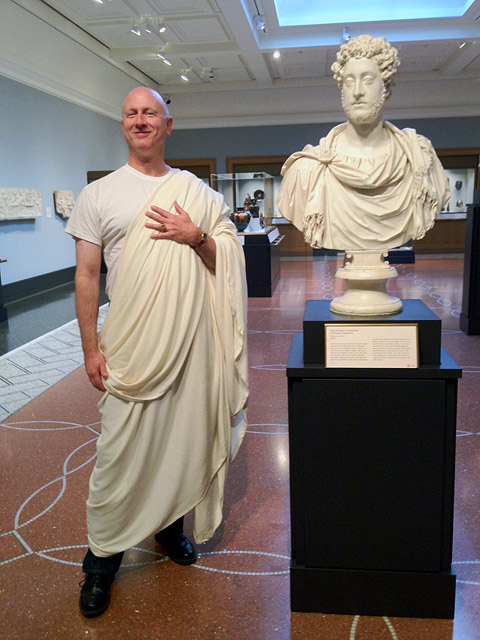In ancient Rome, togas were no laughing matter. They were the fashion must-have for all male citizens, but men hated them: they were heavy, made your left arm as useful as a T. Rex’s, and required a team of highly trained slaves to put on and take off. Also, they were made of wool, which was great for preventing dreaded slippage, but not so great for Mediterranean summers in the pre-antiperspirant era.
On the plus side, togas make you look dignified and imperial, especially when you’re strolling about a Roman estate—the Getty Villa, say. That’s why we’re encouraging students to wear their own home-brewed versions for College Night at the Villa each year. And you don’t have to suffer for fashion: in the video above, education specialist Shelby Brown gives you some tidbits on the history of the toga and shows you (at 2:38) how to wrap yourself comfortably and on the cheap using a twin or full-size sheet.
For advanced toga study, including historical variants, controversies, and primary sources, check out this essay from A Dictionary of Greek and Roman Antiquities; and to round out your ensemble with the appropriate undergarments, footwear, and jewelry, see this article on Roman dress.
Thanks to our impressive toga model Guy Wheatley.





Did the Romans wear t-shirts under their togas?
Hi Chris — In a way, yes! They wore short-sleeve tunics, made of wool like the togas themselves. Some tunics were plain off-white, while others had dark crimson stripes. They definitely didn’t wear salmon-colored button-down shirts as in the video…that was some artistic license on our part.
WOW! You say only prostitutes wore them and then men. Does that mean all men prostitutes?
Hi Janice! Prostitutes did wear them, but so did male citizens (an elite class). Rome was a very status-conscious society, and the etiquette of toga-wearing changed over time. “Respectable” women wore togas in Rome’s early days, but by the Republican era, the only women who wore togas were prostitutes. The article we linked to above has lots of juicy details on the subject. Here’s my favorite sentence: “While the toga was a mark of honor for a man, it was a mark of disgrace for a woman.”
when the “Respectable” women wore togas in Rome’s early days, did they feel disgrace? Is that why they don’t wear togas anymore?
Hi Jackie. I don’t think so; it seems to have been one of those gradual shifts that takes place in fashion. Roman women wore tunics, and married women wore a shawl-like garment on top called the stola, which over time came to replace the toga. So now that respectable ladies (i.e., married ones) no longer wore togas, it seems like the garment got a bad rap.
So, where can one find the pattern for a toga if one doesn’t want to use a sheet?
Hi Clint, Shelby shared with me this link that might be helpful. It shows the shape of the “toga candida”: http://www.fashion-era.com/ancient_costume/roman-costume-history-toga.htm#Toga_Candida_ If you scroll down a little bit from that link, you’ll also see a suggestion for how to create a half-oval of cloth for your toga. It would measure 18 feet on the long side, 7 on the short.
Here’s another good resource with PDFs from a 1924 volume on the subject, which goes into much more detail: http://www.csulb.edu/~dhood/togalink.htm
Good luck!
Did ghandi wear a toga?
Hi David, That’s an interesting question. Not exactly. He wore a dhoti, a traditional Indian garment that is actually quite similar to a toga. For what it’s worth, Hindi and Latin are both Indo-European languages so I checked to see if there might be a common etymology. It doesn’t look like it, though. Toga is from Latin tegere, to cover, while dhoti has a different Sanskrit root. That’s probably more than you wanted to know!
If you google “How to wear a dhoti,” you’ll find some how-to videos.
What is the difference between what ancient greeks wore and what ancient romans wore?
Hi Kyoko, Greek men wore a toga-like garment called the chlamys. But how toga-like was it, exactly? This excellent page from Alan Kennington addresses the issue head-on:
Here is another good resource, a short article from the Metropolitan Museum on ancient Greek dress.
I loved your model! Too funny.
===
Is it true that togas were the equivalent of a modern tuxedo? I’m revising a novel I wrote in 2013 and there is a character (a Roman officer, actually) who wears a toga at one point; but when I learned that togas were like tuxes, I thought, “That’s too formal…he wants to offend her, so he should just wear a tunic and braccae.” Good idea or no?
I’m still looking for how a fibulae fits in to Roman clothing. If togas weren’t normally pinned, then when was a fibulae used?
Hi there, bit late on the boat but a few questions that i cant seem to find answers to, hoping that maybe you guys and gals could help fill in the blanks.
The trim on a toga, would it have been a woolen band or possibly silk?(if i recall, silk was in circulation in roman times, just expensive even for higher class wealth). I pressume it would be appliqued on rather than woven into the original cloth, which brings up another question.
Would the romans use a solid sheet, or would they make the togas from “bolts” of clothes with them seaming the edges together? The thought of trying to make a single length that size back then, with very limited sized looms makes me wonder about the production of such cloths.
Thanks a bunch!
Not what I was looking for but it was cool